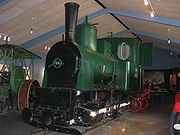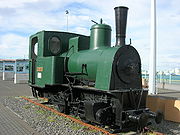
Rail transport in Iceland
Encyclopedia
Iceland
does not have a public railway system and though there have been three small railways none has formed a part of the public transport network.


Harbour Railway, of 900 mm gauge, operated from 1913 until 1928 for the construction of the harbour breakwaters. The railway operated from a quarry outside the city, at the site recognised by tourists today as the Perlan hot water storage plant and revolving restaurant, from which it ran a short distance to a junction, passing loop
, and sidings. This junction was located just south of a large field which became (and remains) the Reykjavík city airport
. From here one line ran to the west, around the edge of the western settlement before proceeding along the newly constructed western harbour pier to the island of Effersey. Here a headshunt
allowed trains to reverse along a further line, built out onto the outer harbour wall, and extended as that wall itself grew longer. From the first junction a second line ran east around farms to a locomotive depot just outside the city and on to a further junction where a short branch line led into a secondary quarrying site (now in the heart of the capital's residential district), whilst the main line continued to a further junction on the edge of the docks. From here one line ran along the quayside (where one of the locomotives is today preserved on display) whilst the other ran out along the eastern harbour wall.
under piles of rubbish, is now an open-air static exhibit in Reykjavík. A scale model of part of this railway, showing one of the locomotives at work, is displayed in the Reykjavík Maritime Museum. Minør was the first to be withdrawn, whilst Pioner (which had received a replacement boiler in 1910 to extend its life) continued to operate until the railway closed in 1928.
In 2004, the first collision of two trains occurred in Iceland. A people car ferrying workers ran into a cement car in a tunnel, lying under Valþjófstaðarfjall mountain. Three people where reported and treated for their injuries in the rail mishap.
was proposed, but the project eventually came to nothing. More recently there have been periodic proposals made to build a passenger railway from Reykjavík to Keflavík International Airport
. Instead, a fast dual carriageway road (road 41
) was built here in 2008. In 2008, 12 representatives from all parties in the Althing
, put forth a proposal to explore the construction of a railway from Reykjavík to Keflavík airport and also a light rail
system within the capital area
.
Iceland
Iceland , described as the Republic of Iceland, is a Nordic and European island country in the North Atlantic Ocean, on the Mid-Atlantic Ridge. Iceland also refers to the main island of the country, which contains almost all the population and almost all the land area. The country has a population...
does not have a public railway system and though there have been three small railways none has formed a part of the public transport network.
Reykjavík Harbour Railway


The track network
Probably the most well-known Icelandic rail project, the ReykjavíkReykjavík
Reykjavík is the capital and largest city in Iceland.Its latitude at 64°08' N makes it the world's northernmost capital of a sovereign state. It is located in southwestern Iceland, on the southern shore of Faxaflói Bay...
Harbour Railway, of 900 mm gauge, operated from 1913 until 1928 for the construction of the harbour breakwaters. The railway operated from a quarry outside the city, at the site recognised by tourists today as the Perlan hot water storage plant and revolving restaurant, from which it ran a short distance to a junction, passing loop
Passing loop
A passing loop is a place on a single line railway or tramway, often located at a station, where trains or trams in opposing directions can pass each other. Trains/trams in the same direction can also overtake, providing that the signalling arrangement allows it...
, and sidings. This junction was located just south of a large field which became (and remains) the Reykjavík city airport
Reykjavík Airport
Reykjavík Airport Reykjavík Airport Reykjavík Airport (Icelandic: Reykjavíkurflugvöllur, is the chiefly domestic airport serving Reykjavík, Iceland. The airport lies two kilometres from Reykjavík's city centre. Possessing rather short runways, it normally only serves flights within Iceland and to...
. From here one line ran to the west, around the edge of the western settlement before proceeding along the newly constructed western harbour pier to the island of Effersey. Here a headshunt
Headshunt
A headshunt is a short length of track, provided to release locomotives at terminal platforms, or to allow shunting to take place clear of main lines.- Terminal Headshunts :...
allowed trains to reverse along a further line, built out onto the outer harbour wall, and extended as that wall itself grew longer. From the first junction a second line ran east around farms to a locomotive depot just outside the city and on to a further junction where a short branch line led into a secondary quarrying site (now in the heart of the capital's residential district), whilst the main line continued to a further junction on the edge of the docks. From here one line ran along the quayside (where one of the locomotives is today preserved on display) whilst the other ran out along the eastern harbour wall.
The locomotives
The railway was operated by two steam locomotives built by the Jung engine company of Germany, both of which have been preserved. Built in the 1890s in Germany, they worked briefly in Denmark before being imported to Iceland in 1913 for the harbour railway project. Locomotive Pioner is now a static exhibit at the Icelandic Folk Museum at Arbær, Árbær Museum, whilst locomotive Minør, after many years of storage in a Nissen hutNissen hut
A Nissen hut is a prefabricated steel structure made from a half-cylindrical skin of corrugated steel, a variant of which was used extensively during World War II.-Description:...
under piles of rubbish, is now an open-air static exhibit in Reykjavík. A scale model of part of this railway, showing one of the locomotives at work, is displayed in the Reykjavík Maritime Museum. Minør was the first to be withdrawn, whilst Pioner (which had received a replacement boiler in 1910 to extend its life) continued to operate until the railway closed in 1928.
The rolling stock
The mainstay vehicle of this railway was the 4-wheeled open wagon. A large number of these wagons operated, and they were built with fully opening sides for loading and unloading. It is not thought that any of these vehicles has survived.Accidents
Iceland's first railway accident was on the Reykjavik Harbour Railway. Records at the Árbær Museum show that both locomotives of the Reykjavík Harbour Railway were involved in accidents between the two world wars. Pioner was deliberately derailed by vandals who placed a chain across the track and weighted down its two sides with rocks. They later claimed that they were testing the locomotive's performance as it had already survived their previous experiments of placing coins and planks on the track. Minør was involved in a genuine accident when a section of track gave way beneath the engine. This was later found to have been caused by rotten wooden sleepers supporting this section of track.Kárahnjúkar Light Railway
A diesel-operated light railway built in the early years of the 21st century in connection with the construction of the Kárahnjúkar hydro-electric power project. The railway consists of three trains, travelling around the clock. Those three trains transport people, concrete, and other things to keep the drilling machines busy. Its lifespan was limited to the construction period of this project, and it has now closed. Much of the equipment used was leased from Italy and has returned there.In 2004, the first collision of two trains occurred in Iceland. A people car ferrying workers ran into a cement car in a tunnel, lying under Valþjófstaðarfjall mountain. Three people where reported and treated for their injuries in the rail mishap.
Korpúlfsstaðir Farm Railway
Korpúlfsstaðir was one of the first industrial farms in Iceland. Built in 1930 by Icelandic industrialist Thor Jensen, it was located on the outskirts of Reykjavík, on the Þingvellir road. The farm was equipped with a 600mm gauge railway network, allowing the transportation of goods and materials around the farm site. The rolling stock consisted chiefly of four-wheel skip wagons. There were no operational locomotives during either documented visit to this railway (in 1984 and 1993), and trains were shunted by hand, by the farm's staff. It is not known whether the railway was originally equipped with locomotives. Korpúlfsstaðir Farm has now closed and the site has been developed as a golf course and an elementary school, incorporating most of the original farm buildings. There is no surviving part of this railway network.Other proposed railways
In the 1920s a mainline railway from Reykjavík to SelfossSelfoss (town)
Selfoss is a town in southern Iceland on the banks of Ölfusá river.It is part, and seat, of the municipality Árborg. The Ring Road runs through the town on its way between Hveragerði and Hella...
was proposed, but the project eventually came to nothing. More recently there have been periodic proposals made to build a passenger railway from Reykjavík to Keflavík International Airport
Keflavík International Airport
-Cargo airlines:-Ground transport:Transport between the airport and Reykjavik city is by road only. The distance is 50 km. A new fast freeway was opened 2008. The buses have a timetable adapted to the flight schedule. They go to and from the Reykjavik bus terminal, taking around 45 minutes...
. Instead, a fast dual carriageway road (road 41
Route 41 (Iceland)
Reykjanesbraut or Highway 41 is a highway that runs from the intersection Miklubrautar, Sæbraut and Western accounting for the air terminal Miðnesi. The road was finished in 1912 and was paved in 1965...
) was built here in 2008. In 2008, 12 representatives from all parties in the Althing
Althing
The Alþingi, anglicised variously as Althing or Althingi, is the national parliament of Iceland. The Althingi is the oldest parliamentary institution in the world still extant...
, put forth a proposal to explore the construction of a railway from Reykjavík to Keflavík airport and also a light rail
Light rail
Light rail or light rail transit is a form of urban rail public transportation that generally has a lower capacity and lower speed than heavy rail and metro systems, but higher capacity and higher speed than traditional street-running tram systems...
system within the capital area
Greater Reykjavík Area
The Greater Reykjavík Area is a name used collectively for Reykjavík and seven municipalities around it.. The area is the largest urban area in Iceland. Each municipality has its independent elected council. With a population of 200,852, the Greater Reykjavík Area comprises over 60% of the...
.

